Dowaksa Aksaca „¢ a 38 3k Continuous Carbon Fiber Price
What is carbon fiber 3D printing?
In 3D printing, carbon fiber is increasingly used to reinforce other materials, usually thermoplastics. The key objective is to make parts stronger and lighter, coveted properties for numerous applications in a wide range of industries. In some cases, carbon fiber-enforced prints can even replace parts that are traditionally made of metal.
Two main methods exist to reinforce 3D parts with carbon fiber: using carbon-fiber-filled filaments or directly integrating a strand of fiber into each layer while it is being printed.
However, and this will be our primary focus here, continuous carbon fiber 3D printing provides much more strength and reinforcement possibilities. Engineers can choose the direction in which the part should be reinforced, resulting in strategically anisotropic parts, whereas chopped carbon fiber filaments boost strength in an isotropic manner.
Here is an example of strategic carbon fiber reinforcement:

Within the continuous carbon fiber additive manufacturing market, however, the options can be quite diverse. You can find standard-looking desktop and benchtop 3D printers, enormous gantry-style systems, complex robotic arms, … and technologies that can range from extrusion to lamination and two-step processes requiring multiple machines.
Taking that into account, we split our selection into two lists to give a more meaningful, actionable overview of this market. On one hand, we grouped continuous CF 3D printers that can be considered office-friendly and/or off-the-shelf (to a minimum extent) solutions. Most of them cost less than $100K and are relatively easy to use.
On the other, we listed solutions with robotic arms (non-planar 3D printing) and/or large-scale footprints. They're more complex to implement and they cost several hundred thousand dollars.
There will always be exceptions, overlaps, and different standpoints that could make one solution fall into one or the other– our split isn't to be taken literally! But if you're looking for a continuous carbon fiber 3D printing system, this article should help you get a good understanding and overview of the market.
Benchtop or "off-the-shelf" continuous carbon fiber 3D printers
The carbon fiber 3D printer list below includes solutions that are relatively turnkey. While some are borderline for this category, like the big Prom IS 500 or the two-step Red Series, they're still much easier to implement and affordable than what our second list covers.
| Brand | Product | Build size | Country | Price Approximate starting prices based on supplier-provided information and public data. Prices may vary by region, over time and do not include additional products or services (taxes, shipping, accessories, training, installation, …). | |
|---|---|---|---|---|---|
| Anisoprint | Composer A4 This product has been reviewed by our team. | 297 × 210 × 140 mm 11.69 × 8.27 × 5.51 in | Luxembourg | $ 16,500 15 000 € 14,636 £ 2,459,424 ¥ | Quote |
| Markforged | Mark Two | 320 × 132 × 154 mm 12.6 × 5.2 × 6.06 in | United States | $ 20,000 20 000 € 17,741 £ 2,981,120 ¥ | Quote |
| Anisoprint | Composer A3 | 460 × 297 × 210 mm 18.11 × 11.69 × 8.27 in | Luxembourg | $ 30,000 27 000 € 26,611 £ 4,471,680 ¥ | Quote |
| Markforged | X7 | 330 × 270 × 200 mm 12.99 × 10.63 × 7.87 in | United States | $ 69,900 69 900 € 62,004 £ 10,419,014 ¥ | Quote |
| 9T Labs | Red Series | 350 × 300 × 150 mm 13.78 × 11.81 × 5.91 in | Switzerland | $ 95,000 96 567 € 84,269 £ 14,160,320 ¥ | Quote |
| APS – Tech Solutions | Wizard 480+ | 400 × 230 × 370 mm 15.75 × 9.06 × 14.57 in | Austria | $ 100,000 100 000 € 88,704 £ 14,905,600 ¥ | Quote |
| Anisoprint | Prom IS 500 | 600 × 420 × 300 mm 23.62 × 16.54 × 11.81 in | Luxembourg | upon request | Quote |
| Desktop Metal | Fiber HT | 310 × 240 × 270 mm 12.2 × 9.45 × 10.63 in | United States | upon request | Quote |
The products in the table are ranked by price (low to high).
| Brand | Product | Build size | Extruder temp. | Build plate temp. | Build chamber temp. | Country | Price Approximate starting prices based on supplier-provided information and public data. Prices may vary by region, over time and do not include additional products or services (taxes, shipping, accessories, training, installation, …). | |
|---|---|---|---|---|---|---|---|---|
| Anisoprint | Composer A4 This product has been reviewed by our team. | 297 × 210 × 140 mm 11.69 × 8.27 × 5.51 in | 270°C | 120°C | – | Luxembourg | $ 16,500 15 000 € 14,636 £ 2,459,424 ¥ | Get a quote |
| Markforged | Mark Two | 320 × 132 × 154 mm 12.6 × 5.2 × 6.06 in | – | – | – | United States | $ 20,000 20 000 € 17,741 £ 2,981,120 ¥ | Get a quote |
| Anisoprint | Composer A3 | 460 × 297 × 210 mm 18.11 × 11.69 × 8.27 in | 270°C | 120°C | – | Luxembourg | $ 30,000 27 000 € 26,611 £ 4,471,680 ¥ | Get a quote |
| Markforged | X7 | 330 × 270 × 200 mm 12.99 × 10.63 × 7.87 in | – | – | – | United States | $ 69,900 69 900 € 62,004 £ 10,419,014 ¥ | Get a quote |
| 9T Labs | Red Series | 350 × 300 × 150 mm 13.78 × 11.81 × 5.91 in | 400°C | – | 100°C | Switzerland | $ 95,000 96 567 € 84,269 £ 14,160,320 ¥ | Get a quote |
| APS – Tech Solutions | Wizard 480+ | 400 × 230 × 370 mm 15.75 × 9.06 × 14.57 in | 500°C | 200°C | 70°C | Austria | $ 100,000 100 000 € 88,704 £ 14,905,600 ¥ | Get a quote |
| Anisoprint | Prom IS 500 | 600 × 420 × 300 mm 23.62 × 16.54 × 11.81 in | 410°C | – | 160°C | Luxembourg | upon request | Get a quote |
| Desktop Metal | Fiber HT | 310 × 240 × 270 mm 12.2 × 9.45 × 10.63 in | – | – | – | United States | upon request | Get a quote |
Below, we give some more context and information about each of these continuous carbon fiber 3D printer options.

Selection This product is featured in a buyer's guide.
Tested This product has been reviewed by our team.
Composer A4
By Anisoprint

| Country | Luxembourg |
| Build size | 297 × 210 × 140 mm 11.69 × 8.27 × 5.51 in |
| Technology | Extrusion |
| Price Approximate starting prices based on supplier-provided information and public data. Prices may vary by region, over time and do not include additional products or services (taxes, shipping, accessories, training, installation, …). | $ 16,500 15 000 € 14,636 £ 2,459,424 ¥ |
Anisoprint is a Luxembourg-based company that specializes in composite carbon fiber and basalt fiber printing technologies. The Composer is their flagship machine, which comes in two sizes, A3 and A4. It boasts a "co-extruder" which mixes a thermoplastic filament with a single continuous strand of carbon fiber.
Parts printed with Anisoprint's CFC technology (Composite Fiber Co-extrusion) boast up to twenty times more strength than parts made with basic plastic. They're also said to be four times lighter than Titanium-made parts.
The Composer A4, its feature-packed software, open material possibilities, and Anisoprint's training packages make for an excellent price-to-performance ratio.
Read our in-depth review of the Anisoprint Composer series for more information.
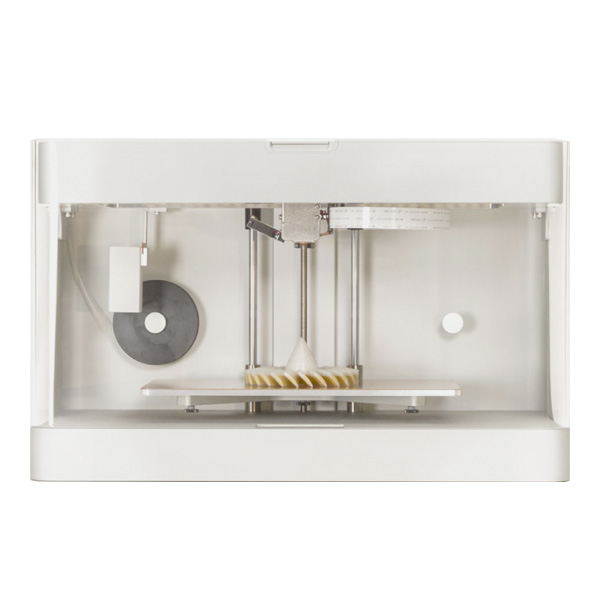
Selection This product is featured in a buyer's guide.
Mark Two
| Country | United States |
| Build size | 320 × 132 × 154 mm 12.6 × 5.2 × 6.06 in |
| Technology | Extrusion |
| Price Approximate starting prices based on supplier-provided information and public data. Prices may vary by region, over time and do not include additional products or services (taxes, shipping, accessories, training, installation, …). | $ 20,000 20 000 € 17,741 £ 2,981,120 ¥ |
While the Markforged X7 is destined for industrial use, the Mark Two is a smaller, desktop carbon fiber 3D printer.
It's compatible with a range of other fiber reinforcement materials, including fiberglass, Kevlar, and HSHT (High-Strength High-Temperature) fiberglass. As for base filament, it is only possible to use Markforged Onyx material.
The Mark Two's print bed is easily removable, enabling users to pause a print, take the print bed out to add components to the part in progress, and to put the plate back into the machine to continue 3D printing.
If you're looking for something more affordable, the Onyx Pro ($6,999) is available as well to reinforce Onyx chopped carbon fiber filament with a continuous strand of fiberglass.

Selection This product is featured in a buyer's guide.
Composer A3
By Anisoprint

| Country | Luxembourg |
| Build size | 460 × 297 × 210 mm 18.11 × 11.69 × 8.27 in |
| Technology | Extrusion |
| Price Approximate starting prices based on supplier-provided information and public data. Prices may vary by region, over time and do not include additional products or services (taxes, shipping, accessories, training, installation, …). | $ 30,000 27 000 € 26,611 £ 4,471,680 ¥ |
The Composer A3 is the largest of Anisoprint's Composer series. It boasts the same features as the aforementioned A4, but with almost triple the build volume.
Read our in-depth review of the Anisoprint Composer series for more information.
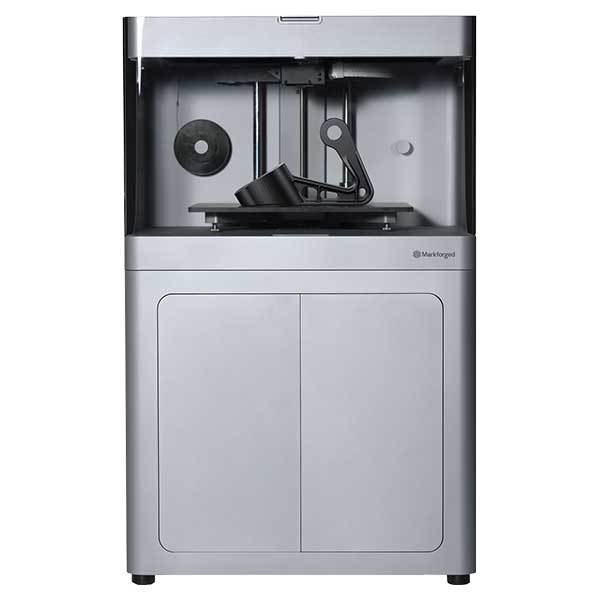
Selection This product is featured in a buyer's guide.
X7
| Country | United States |
| Build size | 330 × 270 × 200 mm 12.99 × 10.63 × 7.87 in |
| Technology | Extrusion |
| Price Approximate starting prices based on supplier-provided information and public data. Prices may vary by region, over time and do not include additional products or services (taxes, shipping, accessories, training, installation, …). | $ 69,900 69 900 € 62,004 £ 10,419,014 ¥ |
The X7 prints Markforged's proprietary Onyx filament– a strong Nylon that is already reinforced with chopped carbon fiber- and continuously reinforces it with a strand of carbon fiber. Hence, the printer delivers extremely strong parts. It is also very precise thanks to its built-in laser micrometer that constantly 3D scans the build area.
Their X series also includes the X3 for chopped carbon fiber filament, and the X5 for continuous fiberglass 3D printing.

Selection This product is featured in a buyer's guide.
Red Series
| Country | Switzerland |
| Build size | 350 × 300 × 150 mm 13.78 × 11.81 × 5.91 in |
| Technology | Extrusion |
| Price Approximate starting prices based on supplier-provided information and public data. Prices may vary by region, over time and do not include additional products or services (taxes, shipping, accessories, training, installation, …). | $ 95,000 96 567 € 84,269 £ 14,160,320 ¥ |
9T Labs is a young innovative company focused on automated composites production based in Switzerland. Its two-step Red Series combines a classical FDM printing unit and an adjacent Fusion Unit for post-processing, both produced by 9T Labs.
The part is first printed on the "Build Module", to then undergo high heat and pressure in the "Fusion Module" and achieve its final, condensed form.
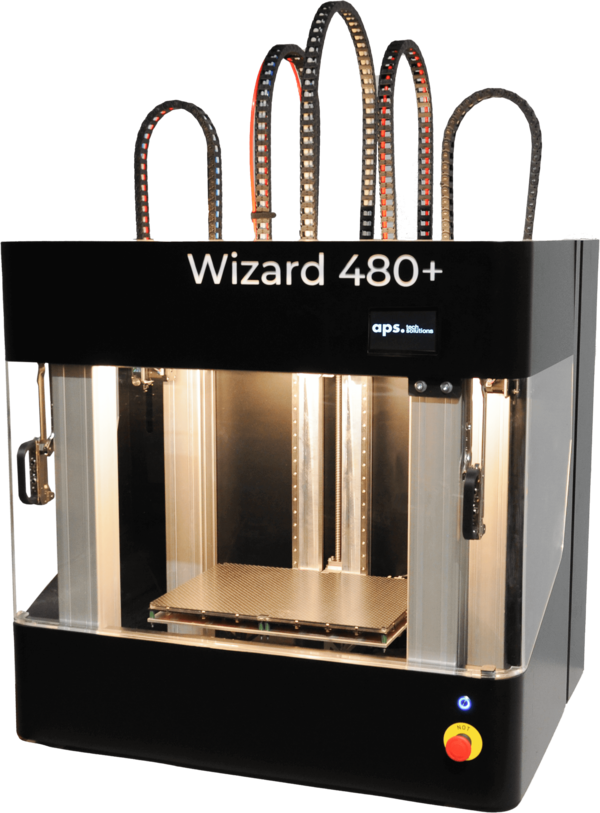
Selection This product is featured in a buyer's guide.
Wizard 480+
| Country | Austria |
| Build size | 400 × 230 × 370 mm 15.75 × 9.06 × 14.57 in |
| Technology | Extrusion |
| Price Approximate starting prices based on supplier-provided information and public data. Prices may vary by region, over time and do not include additional products or services (taxes, shipping, accessories, training, installation, …). | $ 100,000 100 000 € 88,704 £ 14,905,600 ¥ |
The Wizard 480+ is an industrial high-temperature 3D printer produced by APS – Tech Solutions. APS – Tech Solutions is a 3D printer manufacturer based in Austria.
This versatile 3D printing solution is compatible with a range of materials: thermoplastics, including high-performance (PEEK, ULTEM, …); metal (sintering); ceramic (sintering); continuous fibers (including Carbon, Aramid, and metal wires).
It features an automatic tool changer that can swap between four different print heads.

Selection This product is featured in a buyer's guide.
Prom IS 500
By Anisoprint

| Country | Luxembourg |
| Build size | 600 × 420 × 300 mm 23.62 × 16.54 × 11.81 in |
| Technology | Extrusion |
| Price Approximate starting prices based on supplier-provided information and public data. Prices may vary by region, over time and do not include additional products or services (taxes, shipping, accessories, training, installation, …). | upon request |
This continuous fiber 3D printer offers a large build volume of 600 x 420 x 300 mm. Like the Composer series, it uses Anisoprint's patented CFC technology, which stands for Composite Fiber Co-extrusion.
A drying chamber is integrated into the machine and can hold up to six spools of filament. An optional high-temperature extruder (410°C) and heated chamber (160°C) are available for PEEK and PEI (ULTEM).
The Prom IS 500 can use up to four extruders and is compatible with both 1.75mm and 2.85mm filament. Available nozzle diameters range from the standard 0.4mm up to 1.2mm.

Selection This product is featured in a buyer's guide.
Fiber HT
| Country | United States |
| Build size | 310 × 240 × 270 mm 12.2 × 9.45 × 10.63 in |
| Technology | Extrusion |
| Price Approximate starting prices based on supplier-provided information and public data. Prices may vary by region, over time and do not include additional products or services (taxes, shipping, accessories, training, installation, …). | upon request |
Desktop Metal is mostly known for their disruptive metal 3D printers. Their Fiber series, which includes the Fiber LT and Fiber HT, however, tackles the continuous carbon fiber 3D printing niche.
Packed in a user-friendly system, their Micro AFM (μAFP or Micro Automated Fiber Placement) technology offers extremely strong and lightweight parts. The LT version allows you to reinforce PA6 (Nylon) with a continuous strand– or "tape" as called by Desktop Metal– of Carbon Fiber or Fiberglass.
Users that need to use more resistant materials should opt for the HT version, which is able to 3D print and reinforce high-performance polymers like PEEK.
Note: As of July 2022, this solution is not yet available for order.
Robotic arms and large-scale carbon fiber 3D printers
This section covers large-scale carbon fiber 3D printers and robotic-arm solutions for non-planar carbon fiber 3D printing.
The products in the table are ranked by price (low to high).
Below, we give some more context and information about each robotic arm carbon fiber 3D printer from our selection.
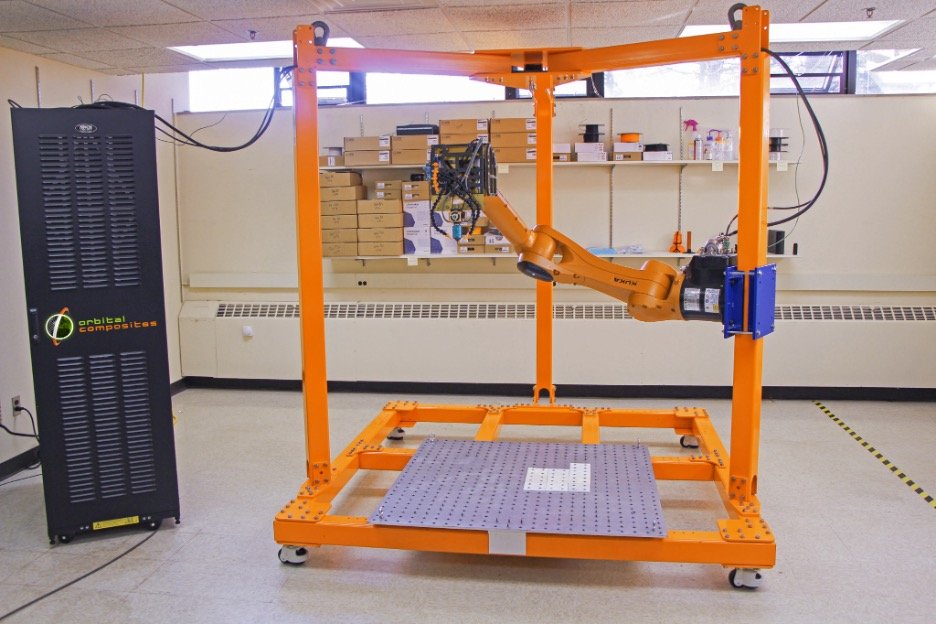
Selection This product is featured in a buyer's guide.
Orbital S
| Country | United States |
| Build size | 1000 × 1000 × 1000 mm 39.37 × 39.37 × 39.37 in |
| Technology | Extrusion |
| Price Approximate starting prices based on supplier-provided information and public data. Prices may vary by region, over time and do not include additional products or services (taxes, shipping, accessories, training, installation, …). | upon request |
The Orbital S is a large-scale carbon fiber 3D printer composed of a robotic arm mounted within an open chassis. Orbital Composites markets this solution as an industrially scalable system, where factories could operate several Orbital S systems for the mass production of large end-use parts.

Selection This product is featured in a buyer's guide.
AM Flexbot
| Country | Netherlands |
| Build size | – |
| Technology | Extrusion |
| Price Approximate starting prices based on supplier-provided information and public data. Prices may vary by region, over time and do not include additional products or services (taxes, shipping, accessories, training, installation, …). | upon request |
CEAD is a manufacturer from the Netherlands that produces custom, large-scale composite 3D printers for industrial use. Their AM Flexbot is a modular robotic arm system that can be implemented in different environments and with varying tool heads (extrusion, CNC milling, etc.).

Selection This product is featured in a buyer's guide.
CF3D
| Country | United States |
| Build size | – |
| Technology | Resin > Other |
| Price Approximate starting prices based on supplier-provided information and public data. Prices may vary by region, over time and do not include additional products or services (taxes, shipping, accessories, training, installation, …). | upon request |
The CF3D ("Continuous Fiber 3D Printing") is an industrial continuous fiber 3D printer produced by Continuous Composites, a US-based manufacturer. This continuous fiber manufacturing system deposits an uninterrupted strand of fiber while simultaneously coating it with a fast-curing resin. The UV light source at the tip of the printhead cures the coated fiber as it is deposited.

Selection This product is featured in a buyer's guide.
CBAM-2
| Country | United States |
| Build size | 305 × 305 × 102 mm 12.01 × 12.01 × 4.02 in |
| Technology | Lamination |
| Price Approximate starting prices based on supplier-provided information and public data. Prices may vary by region, over time and do not include additional products or services (taxes, shipping, accessories, training, installation, …). | upon request |
Launched in 2019, this US-based company's industrial machine uses thermoplastic powders combined with sheets of carbon fiber or fiberglass. CBAM stands for Composite-Based Additive Manufacturing and is a combination of lamination and binder jetting.
First, an inkjet print head deposits a liquid onto a sheet of woven fiber, in the particular layer's shape (e.g. circle). Then, a layer of polymer powder is deposited onto the sheet. The powder sticks to the areas where the liquid was deposited. After that, the dry, leftover powder is swept off. The stacked layers are then heated and compressed to leave the final part.
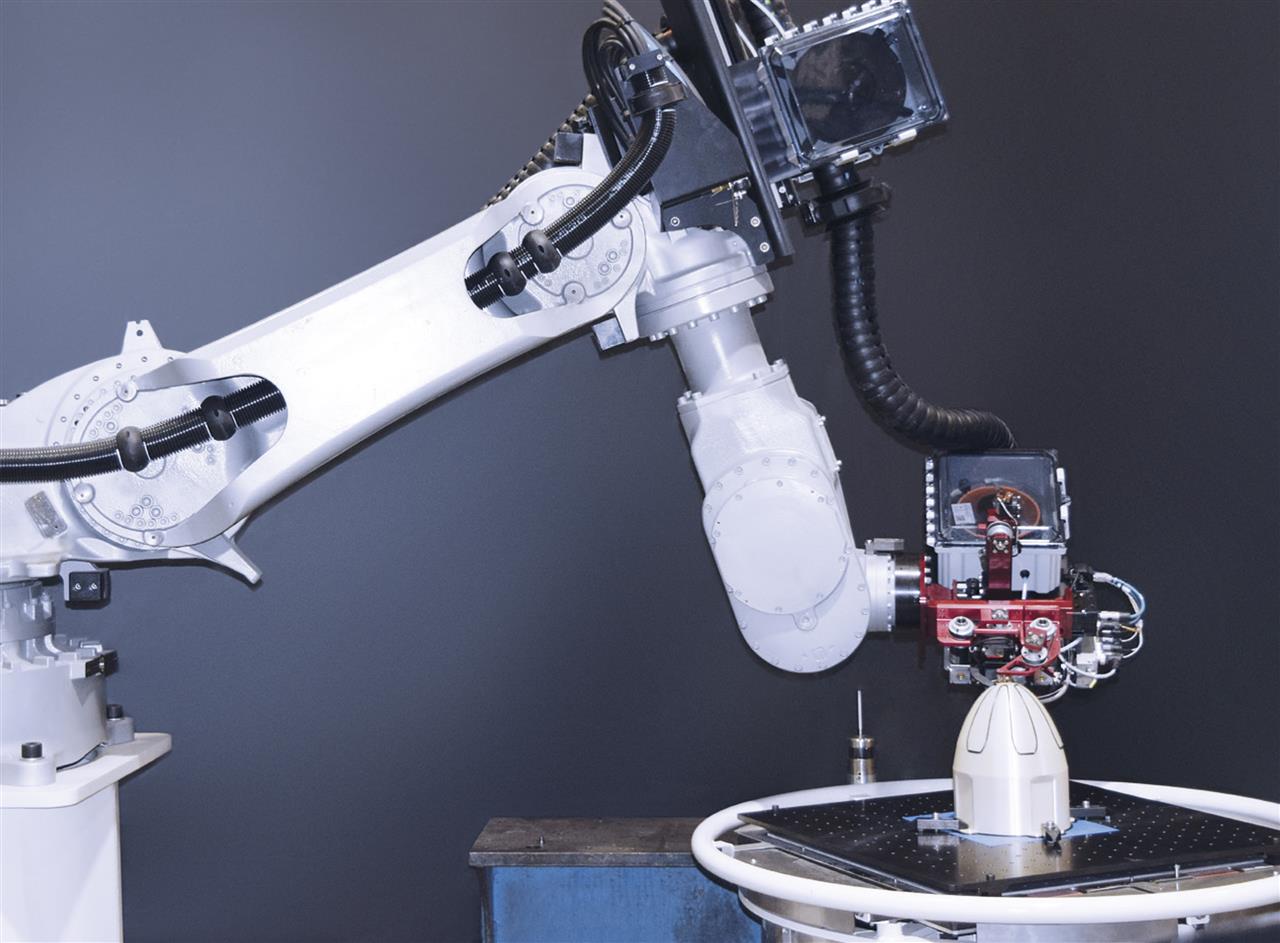
Selection This product is featured in a buyer's guide.
MasterPrint Continuous Filament
| Country | United States |
| Build size | – |
| Technology | Extrusion |
| Price Approximate starting prices based on supplier-provided information and public data. Prices may vary by region, over time and do not include additional products or services (taxes, shipping, accessories, training, installation, …). | upon request |
The MasterPrint Continuous Filament is a continuous fiber robotic arm 3D printer produced by Ingersoll. It features six axes of movement, plus a seventh axis thanks to the rotary build plate. The MasterPrint Continuous Filament can 3D print carbon fiber parts from scratch or print on existing parts. It is composed of a Comau robotic arm and two extruders– a continuous fiber extruder and a general-purpose extruder for other materials.
Continuous fiber vs. chopped carbon fiber 3D printing
There is a big difference between printing with continuous fibers and printing with chopped carbon fiber filament.
Continuous fiber 3D printing
In this method, long,continuous strands of carbon fiber are mixed with thermoplastic base material during the 3D printing process. The base material, also called matrix material, can be PLA, ABS, Nylon, PETG, PEEK, or almost any other thermoplastic.
One way to reinforce parts with continuous carbon fiber is by using a dual extruder or two-in-one extruder, wherea special nozzle deposits a single strand of fiber at the same time as the other nozzle heats and prints the base material. Markforged and Anisoprint use this kind of technology.
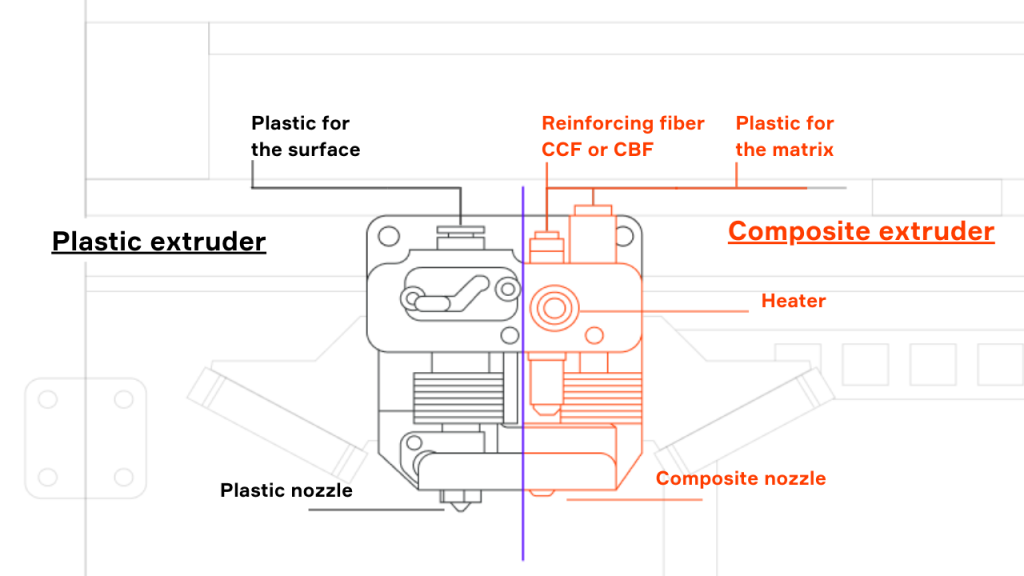
Continuous Composites, on the other hand, uses hybrid technology. Their system soaks a strand of fiber with resin, to thensolidify it with UV light when it comes out of the nozzle. In other, simple words, it's a mix of extrusion and photopolymerization.
9T Labs also uses a hybrid approach; the first module prints the composite part, and the second applies high heat and pressure to weld the layers together.
Chopped carbon fiber filament 3D printing
Chopped carbon fiber– or carbon-filled– filament, is the most common way to 3D print carbon fiber. Carbon fiber is already integrated into the filament and ready to print on a more or less standard FFF 3D printer.
A base material (again, PLA, Nylon, or other thermoplastics) is mixed with extremely small bits of carbon fiber. These small carbon fiber strands are abrasive, so the 3D printer will require a hardened steel nozzle or other tough nozzle to resist.
Parts printed with this type of filament are stronger than regular thermoplastic prints. That being said, the percentage of fiber used and the base thermoplastic (among other variables) determine how strong the final product is.
Other high-resistance composite materials for continuous fiber 3D printing
Various continuous fiber 3D printers are compatible with other types of fibers in addition to carbon.
Fiberglass 3D printing
This entry-level reinforcement material can produce parts that are considerably stronger and stiffer than ABS and Nylon. It is more flexible than carbon fiber and is less expensive.
Kevlar fiber 3D printing
Kevlar is another interesting fiber to 3D print with, especially when it comes to shock absorption.
Basalt fiber 3D printing
Basalt fiber parts can be as strong as stainless steel and five times lighter than steel.
Reinforcing parts with continuous carbon fiber
When using continuous fiber 3D printing with extrusion-type 3D printers, there are two different ways to reinforce parts.
- Outer layer or wall reinforcement (concentric)
- Inner infill reinforcement (isotropic)
It's interesting and important to know what you'll need for each part in order to optimize your carbon fiber stock.
In some cases, reinforcing only the perimeters of the part will be enough. Other applications may require a light carbon fiber infill, and others might need a very dense infill, which will be more expensive to print as it uses much more material.
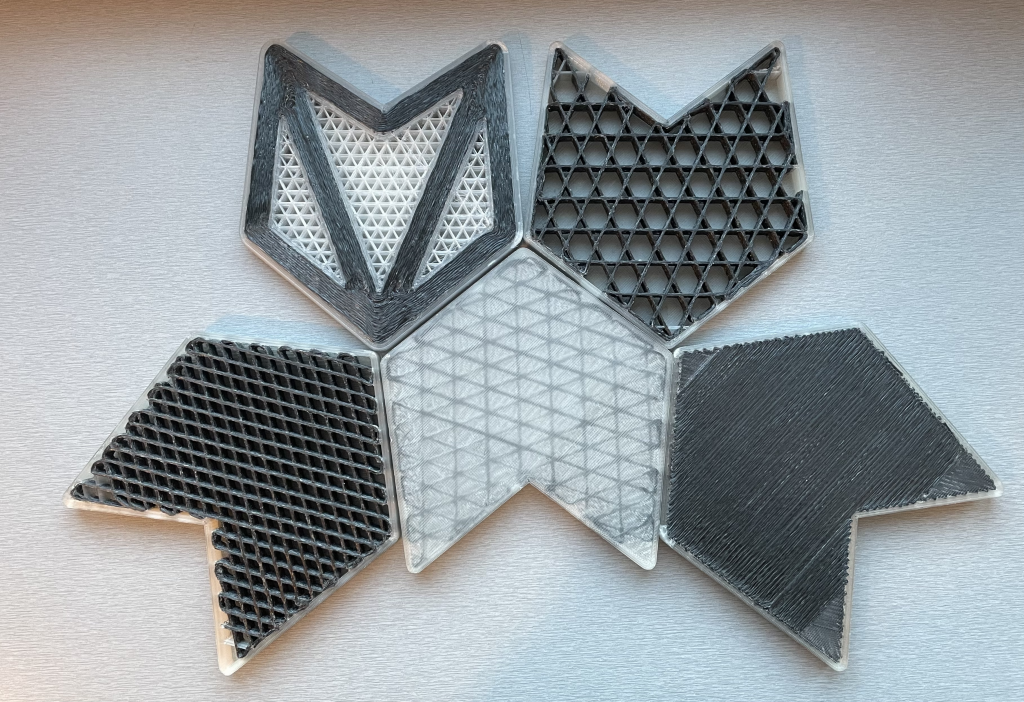
3D printing carbon fiber composites: pros and cons
Like any material or technology, continuous carbon 3D printing has both advantages and limits.
Pros of continuous carbon fiber printing
Continuous carbon fiber 3D printing can produce parts that:
- Boast high strength, stiffness, and dimensional stability
- Are lightweight
- Have a greatsurface finish and appearance
It is alsoeasy to work with and 3D print, and can be mixed with many different kinds of thermoplastic materials.
Cons of 3D printing parts with carbon fiber
The few disadvantages of carbon fiber include:
- Limited colorchoice (shades of dark grey)
- High price
This material is also brittle, but that can be compensated for when paired with a non-brittle plastic.
Carbon fiber 3D printing services
While printing with carbon fiber can produce amazing results, it's not for everyone – especially if you don't have the right machine. For businesses that only require a few parts per year, it may not be worth it to invest in a continuous carbon fiber 3D printer. If you're interested in having something printed in carbon fiber or other materials, check out our guide to 3D printing services. You send them your 3D model, they print it with industrial-grade 3D printers, and ship the part to you.
FAQ
Can any 3D printer print carbon fiber?
With the right nozzle and a heated bed, any standard FFF 3D printer can 3D print carbon fiber.
Can you 3D print fiberglass?
It is possible to 3D print fiberglass with a continuous fiber 3D printer.
What is composite 3D printing?
Composite 3D printing is 3D printing materials that are a mix of two or more different materials. Some composite material examples include wood-filled PLA, carbon PEEK, and carbon PA.
Source: https://www.aniwaa.com/buyers-guide/3d-printers/carbon-fiber-3d-printers/
0 Response to "Dowaksa Aksaca „¢ a 38 3k Continuous Carbon Fiber Price"
Post a Comment